How to recreate your favourite Japanese dishes at home
From flower-shaped sushi to an Asian-inspired Sunday roast, here’s six recipes from Japan Centre as the iconic London food hall celebrates its 45th anniversary. By Hannah Twiggs

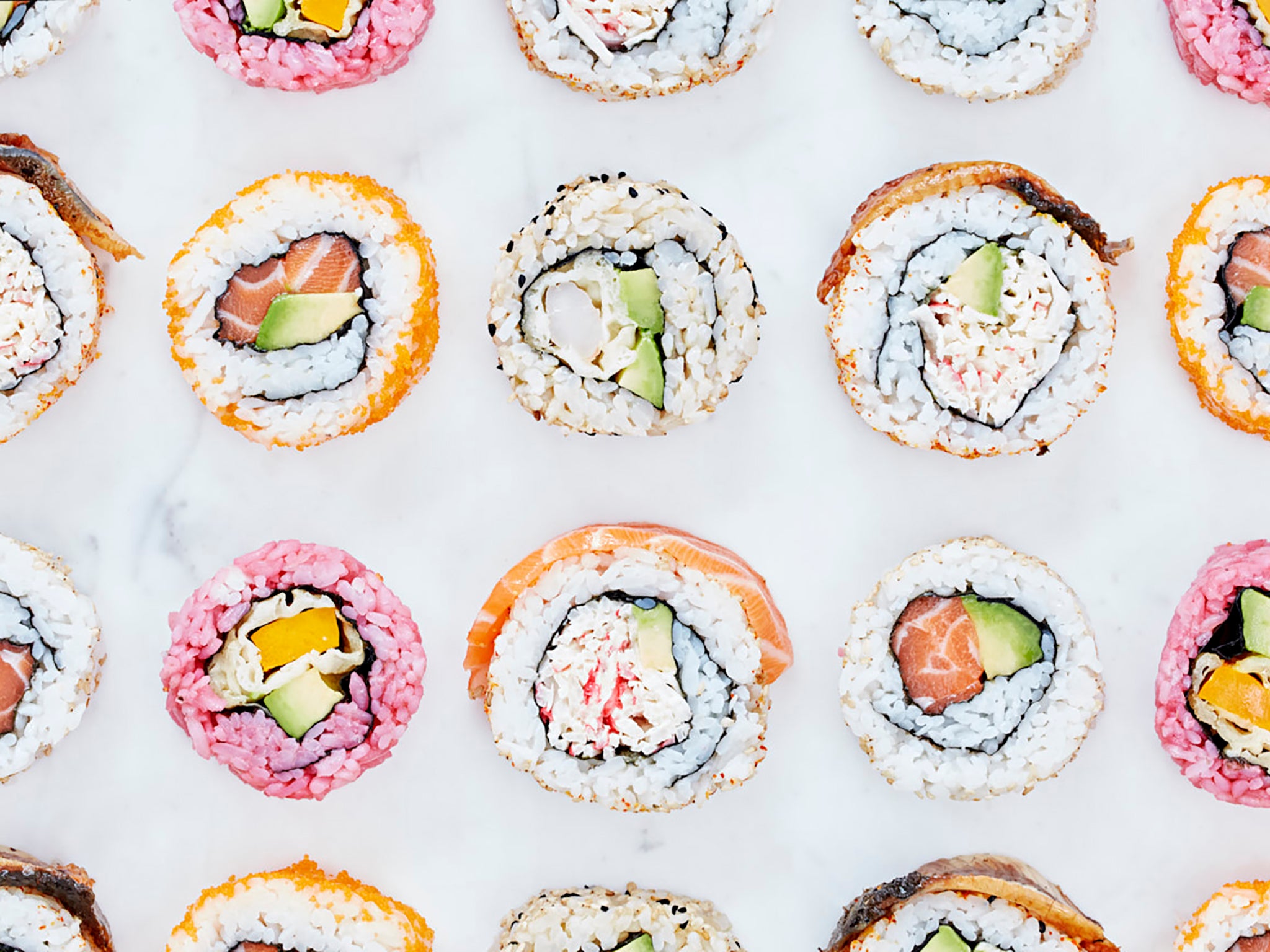
In 1976, a young Tak Tokumine started selling Japanese books in London. At first, his customers were expats longing for a taste of home, which even he had struggled to find since emigrating to the UK to be with his then girlfriend.
He opened the first Japan Centre on Warwick Street, and by 1984 had moved to Soho and expanded to include an Asian supermarket and curry bar, offering ingredients and dishes to Londoners that had thus far been largely undiscovered. As the appetite for Japanese and Asian culture and cuisine in London was going, another move in 1994 to Piccadilly would see the opening of his first standalone restaurant Toku, a precursor to today’s popular Shoryu Ramen restaurants.
Fast forwards 45 years and the chain is still trailblazing the familiarisation of Japanese food in the UK. From humble beginnings as a small bookstore to a chain of authentic ramen bars and food halls, Japan Centre has evolved into a much adored institution over the years, and now boasts several sites feeding and inspiring people across London, an online shop so everyone can try authentic ingredients, and a chain of popular ramen bars.
To celebrate the milestone, throughout July Japan Centre will be hosting a series of virtual cooking classes, interactive workshops and a competition to win a trip to Tokyo for two. Some of the events available include learning the art of origami, a miso-making workshop and an online green tea experience. Whether you’ve been following Tokumine and are a long-time fan of the store, or you’re interested in learning more about the culture and cuisine, there’s something for everyone...
...including this guide to making some of our favourite Japan Centre recipes art home. It’s not all sushi and sashimi (though there are some excellent recipes for hand-rolled sushi and flower-shaped rolls here), there’s the hugely popular karaage (Japanese fried chicken), an Asian-inspired Sunday roast, and the matcha brownies of our dreams.
Temaki zushi (hand-rolled sushi)
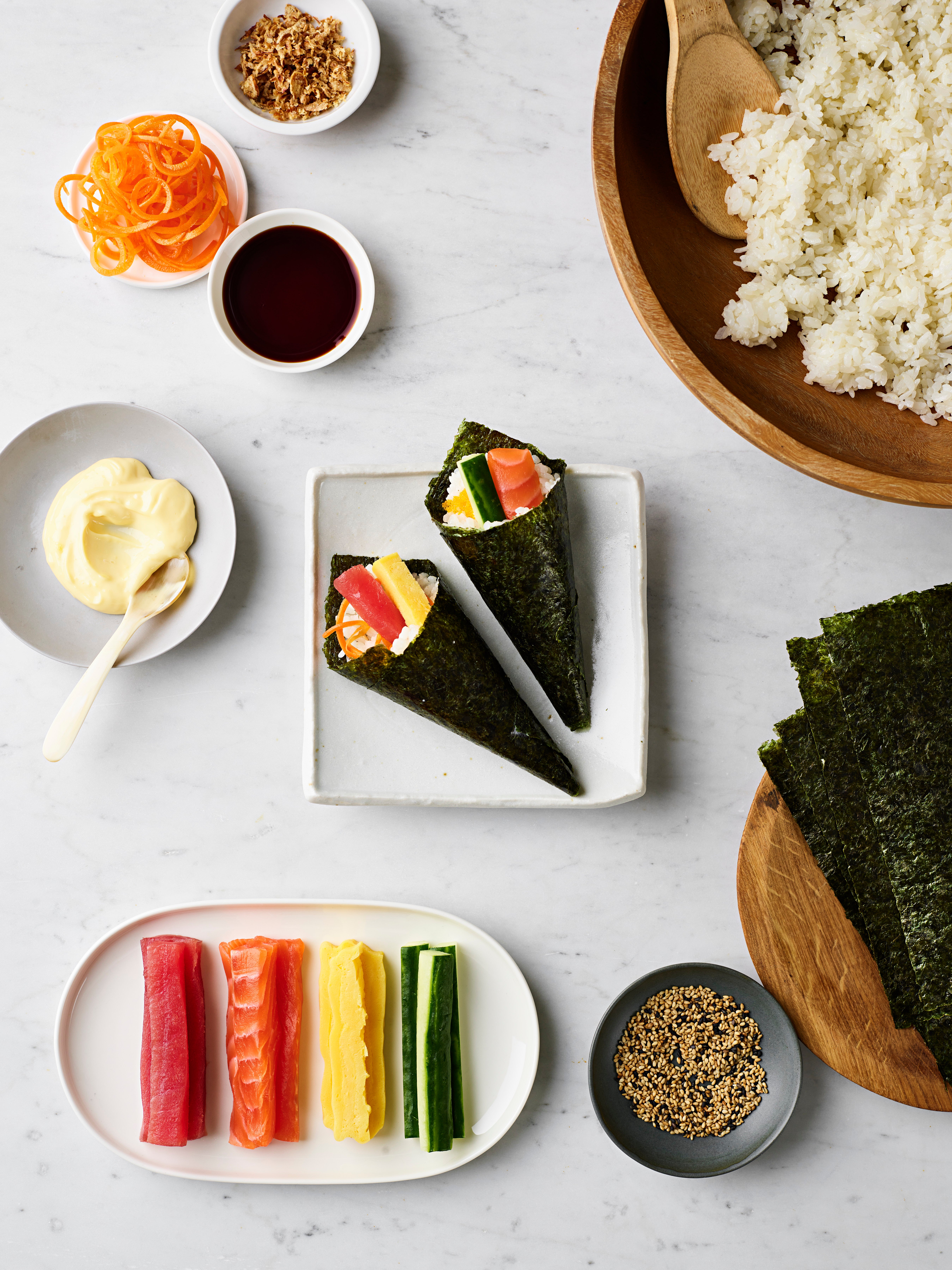
Bring a touch of elegance to your next batch of sushi with this recipe. These cone-shaped sushi rolls look fancy, but actually they are easy to make, taste great, and can contain any fillings you desire. Why not also try fillings such as spicy beef, lettuce and mayonnaise, teriyaki chicken, and salmon and avocado?
Ingredients
200g sushi rice
2 sheets nori seaweed
50ml sushi vinegar
1 tbsp soy sauce (optional)
Suggested fillings:
Tinned tuna with mayonnaise
Tuna
Salmon
Tamagoyaki omelette
Avocado
Seafood sticks
Prawns
Cucumber
Optional seasonings:
Mayonnaise
White sesame
Black sesame
Wasabi
Yuzu kosho pepper
Method
1. After cooking 200g of rice, mix with 50ml of sushi vinegar and leave to cool before using.
2. Prepare your fillings in thin 10cm strips and cut the nori seaweed sheets in half.
3. On the rough side of 1 piece of nori spread your sushi rice so that it covers the left half of it. You do not need to spread rice right to the edges.
4. If you’d like, sprinkle some sesame seeds over the rice for extra flavour.
5. Place the sheet of nori seaweed horizontally in your left hand (you can do this from the beginning but may find it easier after the rice has been spread).
6. Start adding any ingredients in the centre on top of the rice. You can use any combination, but salmon and avocado often compliment each other well.
7. Now to roll the temaki. First fold in the filled side from the left over the filling. Next roll the plain side of nori seaweed in from the right, making a cone with your hands. Secure the end of the roll with a pressed piece of moist rice taken from the filling.
8. Your temaki zushi is now ready to eat, enjoy.
Hina matsuri flower sushi

These cute flower-shaped sushi rolls are made using all natural ingredients, with some plum vinegar, nori seaweed, and seasoned sushi rice. These sushi rolls are a feast for the eyes as well as the taste buds. Enjoy these as part of a main meal, or add to a bento lunchbox
Ingredients
300g white Japanese sushi rice
125g white Japanese sushi rice with plum seasoning
Nori seaweed
Carrot
Ham
Steamed spinach
Method
1. Let’s start by making our sushi rice. If you’ve not cooked sushi rice before, follow our recipe. To make the pink sushi that will form our petals mix 125g of your rice with plum seasoning instead of sushi vinegar.
2. Next up, cut your sheet of nori seaweed into 4 pieces across. You’ll need to cut a strip of equal width from another nori sheet to have enough so we can make 5 petals.
3. With lightly damp hands, place one of your nori strips on the sushi mat, then carefully lay some ham on top. Spoon on 25g of the plum sushi rice down the middle, then roll up the nori over the sides and pinch the rice to make a petal shape. There will be a little gap down the narrower side of each petal where the nori doesn’t quite meet. Repeat with the other four nori strips to make five petals in total.
4. Cut a strip of carrot the same length as your nori to go in the middle, try to make it as round as possible as this will form the centre of our flower. Next, holding the sushi mat in one hand carefully position you first petal in the middle, add another petal to the left and right, then place the carrot in the middle. Add the final 2 petals, making sure all the petals are turned with the narrowest part towards the centre.
5. Unwrap the sushi mat and very carefully place spinach in gaps around the outside of the petals, these will form the leaves.
6. Get a big piece of nori and place it on your sushi mat. Add 250g of sushi rice on top, leaving a 2cm gap at the top and bottom of the nori, and place your petal bundle in the middle width wise across the nori.
7. Carefully, using the sushi mat, roll up the outer nori around the flower shape, until you get to the gaps with no rice. Add the final 50g of rice, gently pushing it down, then fold over the last pieces of nori. Push down on the nori using the sushi mat to seal it in place, then gently roll and shape the finished sushi roll to get it nice and round.
8. Slice into pieces about a thumb’s width in thickness and serve.
Karaage Japanese fried chicken

With karaage chicken by your side, you’ll never want to eat takeaway chicken again. Inspired by Chinese fried chicken recipes, karaage is a delicious izakaya or bento box favourite, comprised of crunchy, deep fried pieces of marinated chicken served with a liberal squeeze of lemon juice or a side pot of kewpie mayonnaise. Perfect eaten hot or cold, this simple recipe is quick to make and produces fantastic results. Great for parties!
Ingredients
300g boneless skin-on chicken thighs
For the marinade:
3 tbsp soy sauce
1 tbsp cooking sake
5g fresh ginger, grated
2 cloves garlic, crushed
To fry:
¼ cup katakuriko potato starch, to coat cooking oil, for frying
To serve:
Japanese mayonnaise lemon wedges
Method
1. Cut chicken into bite-size pieces, leaving a little skin/fat on for extra crispiness.
2. Add the ginger, garlic, soy sauce and cooking sake to a bowl and mix until combined. Add the chicken, coat well, and allow to marinade for 30 minutes.
3. Drain any excess liquid from the chicken and add your katakuriko potato starch. Mix until the pieces are fully coated.
4. Heat some cooking oil in a pan to around 180°C and test the temperature by dropping in some flour (if it sizzles on impact, the oil is hot enough). Fry 3-4 pieces at a time for 3-4 minutes until they are deep golden brown colour, then remove and allow to drain on a wire rack or kitchen roll.
5. Serve hot or cold with some lemon wedges and a squeeze of Japanese mayonnaise.
Sake marinated lamb rump with crispy noodles
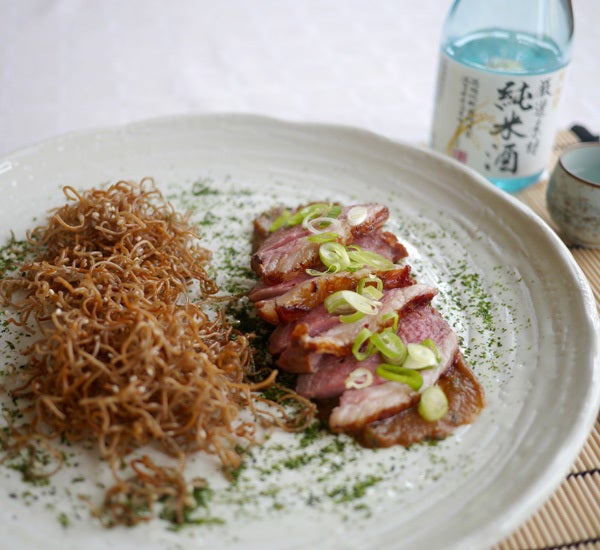
Enjoy the full flavour of sake as an ingredient in cooking with this sake marinated lamb rump and crispy noodles recipe. This hearty dish involves marinating a lamb rump in sake to tenderise the meat and enhance the flavour. Served with an umami-rich aubergine and miso puree and crispy sesame soba noodles, it would make for an exquisite Sunday lunch.
Ingredients
For the lamb:
1 lamp rump, fat scored
2 spring onions, chopped
1 red chilli, deseeded and chopped
3 garlic cloves, crushed
1 piece of fresh ginger, peeled and finely sliced
3 tbsp of tamari 200ml of sake, (suggested to use gekkeikan gensen sozai junmai)
For the aubergine and miso purée:
1 aubergine
1 tbsp of red miso
1 tbsp of caster sugar
2 tbsp of tamari
For the crispy sesame soba noodles:
200g of soba noodles, skinny soba somen preferred
1 tbsp of sunflower oil
1 tbsp of toasted sesame oil
2 tbsp of sesame seeds
To serve:
Seaweed, aonori powdered
1 spring onion, finely sliced
Method
1. Put the lamb into a large sandwich bag and add all the marinade ingredients. Seal the bag and squidge everything together, so the lamb is fully and evenly coated. Pop the bag in the fridge and leave to marinate overnight or for up to 24 hours.
2. To make the aubergine and miso purée, press a barbecue skewer through an aubergine and place it directly over a gas hob ring. Turn the aubergine every now and then until the skin has charred and blackened all over. Scoop out the flesh and discard the burnt skin.
3. Combine the miso, sugar and tamari in a small saucepan over a gentle heat and whisk until the miso and sugar have dissolved. Remove from the heat and add the aubergine pulp. Use a stick blender to blitz the mixture into a smooth purée. Set aside to reheat just before serving.
4. Preheat the oven to the hottest setting.
5. Brush off most of the excess marinade and place the lamb on a baking tray, fat side up. Roast for 5 minutes, before turning the heat down to 200C/gas mark 6 and roast for a further 10-15 minutes, depending on how pink you like your meat. Leave the lamb to rest tented with foil.
6. To make the noodles, simply boil them in salted water according to the packet’s instructions, drain and toss in the oil and sesame seeds. Decant the oiled noodles into a hot wok or frying pan over a medium to high heat and use a fork or chopsticks to turn the noodles over until evenly browned and crispy.
7. To plate up, slice the lamb and place it on a smear of aubergine and miso purée and scatter over some finely sliced spring onions. Serve alongside the crispy sesame soba noodles and dust over the seaweed powder.
Spicy shirataki noodle salad
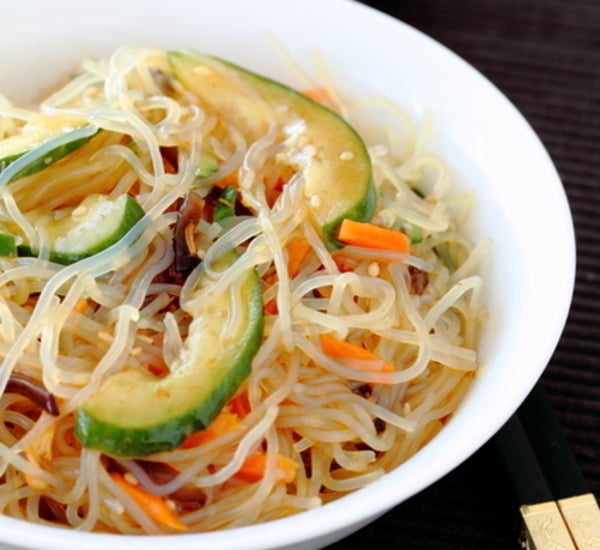
Control your waistline without sacrificing flavour with the help of this spicy shirataki noodle salad. Used in a variety of traditional and modern dishes and adept at absorbing flavours, shirataki noodles have a chewy texture making them perfect for soups, salads or stir-fries, and they are perfect for this recipe because they contain no calories. Serve this tasty noodle salad as an entrée or side dish and let it fill you up.
Ingredients
1 packet shirataki noodles
50g cooked ham
⅓ cucumber
1 small carrot
6 cherry tomatoes
For the sauce:
4 tbsp soy sauce
2 tbsp rice vinegar
½ tbsp sesame oil
¾ tbsp mirin
⅓ tsp karashi mustard powder pinch of black sesame seeds (optional)
½ tsp gochujang chilli paste (optional)
Method
1. Begin by grabbing a bowl and mixing all the sauce ingredients together with a fork. You can change the quantity of karashi mustard or gochujang to adjust the spiciness.
2. Next, open the shirataki packet and drain the shirataki noodles in a colander. Rinse them with clean water a couple of times before boiling them in a pan of water for a few minutes.
3. While your shirataki are boiling, peel and cut the carrot. De-seed and cut the cucumber and ham into strips so they become easier to mix with the shirataki and chop the cherry tomatoes into segments.
4. Once your noodles are ready, drain them in the colander and let them cool down for a few minutes. Cut them into three equal lengths on a cutting board so they are easier to eat.
5. Taking a salad bowl mix the shirataki and vegetables together. Finally, coat with the sauce and mix again. You can serve your shirataki salad as a starter for 2 or a main for 1.
Matcha chocolate brownies
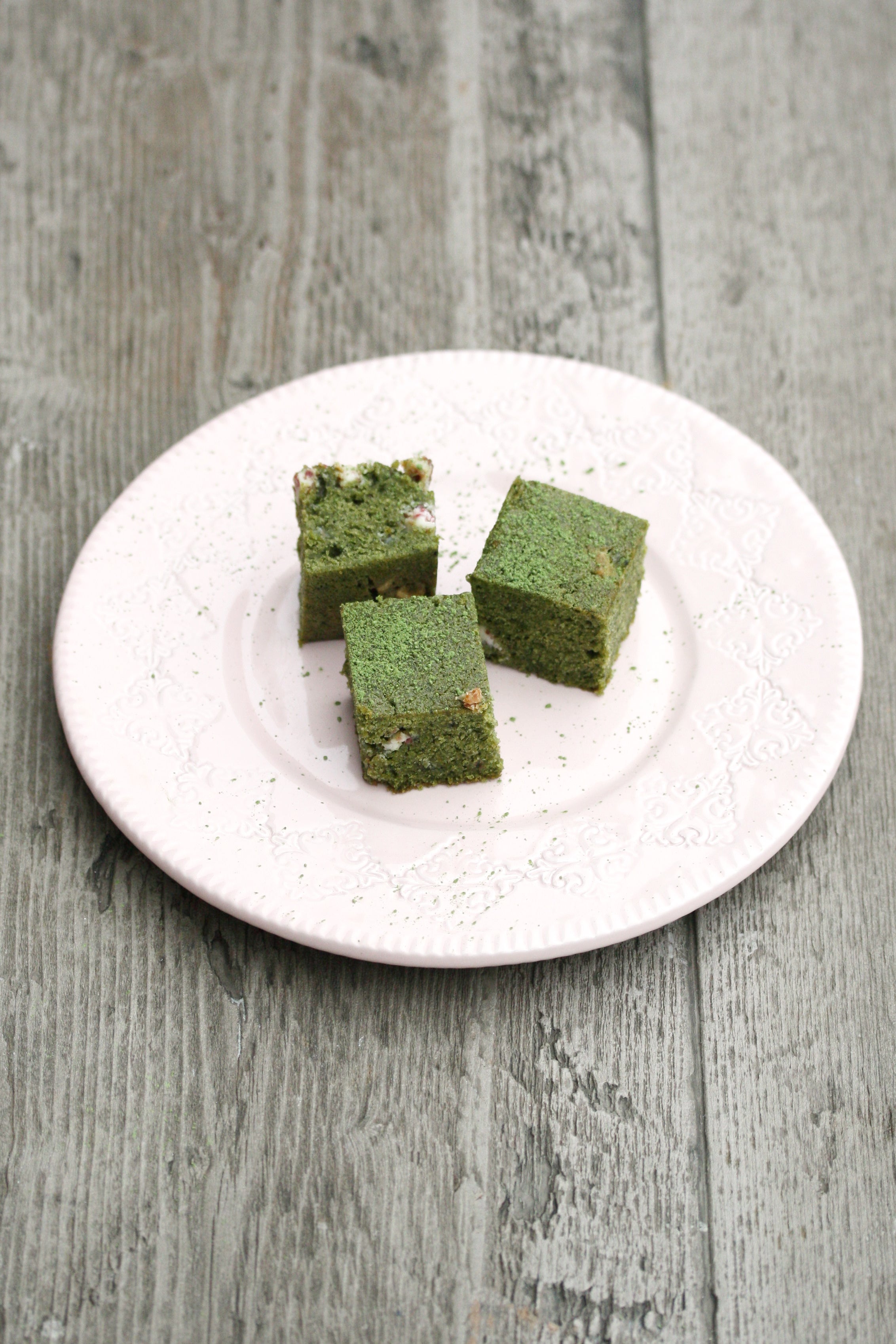
Bring the unique leafy, earthy flavours of matcha green tea to a favourite dessert with these easy matcha chocolate brownies. An absolute must-try for any lover of sweet cakes and matcha combined, these brownies are rich and decadent, with the matcha flavour cutting through any richness from the brownie mix and leaving a cake that is just right. Serve these tasty treats at parties and gatherings, perhaps with a little ice cream.
Ingredients
120g plain flour
30g almond flour
1 tbsp matcha powder
1 tsp baking powder
90g white chocolate chips (or pink chocolate chips, if you can source them)
100g unsalted butter, melted
2 eggs
90g caster sugar
2 tbsp milk
Method
1. Preheat oven to 170C. Place parchment paper in a 15cm-by-15cm square baking tin. Sift plain flour, almond flour, matcha powder, and baking powder together, then set aside.
2. Place the room temperature butter and sugar in a bowl and whisk well until the mixture turns fluffy and white. Add eggs one at a time, whisking the batter well each time.
3. Add sifted ingredients and milk to the batter, then gently mix and fold until batter is fully incorporated. Add the chocolate chips and stir them through the mixture until they are evenly distributed.
4. Bake in oven for 18-20 minutes. Allow to cool before slicing. Dust with a little extra matcha and enjoy.
For more recipes, inspiration and information about the 45th anniversary celebrations, visit Japan Centre’s website, here.
Join our commenting forum
Join thought-provoking conversations, follow other Independent readers and see their replies
0Comments